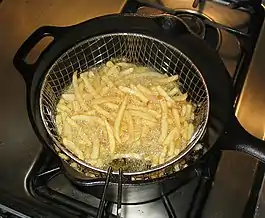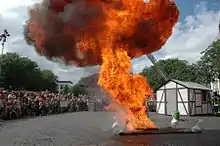Chip pan
A chip pan is a deep-sided cooking pan used for deep-frying. Chip pans are named for their traditional use in frying chips (called "French fries" in the United States).

Today, they are made from either aluminium or stainless steel, although in the past were commonly made from cast iron. A basket is placed inside the pan, to lower the chips into the hot cooking oil, and to raise them once cooked.
Chip pans are commonly used in the United Kingdom and Republic of Ireland, although are slowly being outmoded by deep fryers.[1]
Manufacture
Chip pans are commonly manufactured through a spinning process, as the metal used is malleable. The lid is typically stamped out by a die in a heavy press.[2]
Health issues
Repeated heating of oil is believed to greatly increase the free radicals in the oil, leading to a higher risk of heart disease.[3]
Oil burns
Injuries, particularly to children, caused by the hot oil from a chip pan falling on them are a common cause of hospital admission in the UK.[4][5]
Fire hazard
.jpg.webp)

Chip pans are well known for being a fire hazard. In the UK, chip pan fires are the largest cause of fire-related injuries in the home,[6] such that several local fire brigades have offered a "chip pan amnesty", trading old chip pans for a deep fryer.[7]
By comparison, electric deep fryers feature circuitry and design features (such as thermostat-controlled internal heating elements) that prevent the oil from being heated to the point of ignition. Boil-overs and splattering can still occur for the usual reasons, but the fire danger is largely eliminated.
Chip pans are the most common cause of house fires in the United Kingdom, with around 12,000 chip pan fires every year, 1,100 of them considered serious. These fires result in over 4,600 injuries, and 50 deaths per year. British Fire Brigades frequently issue warnings and advice, urging households to switch to a safer means of cooking chips, and advising that unless the fire is easily contained to leave the fire to the emergency services.[8]
They are also a common cause of fire in the Republic of Ireland, accounting for one-fifth of all domestic fires.[9] After two men died in a 2016 fire in Cork City, a coroner recommended that the sale of chip pans be banned and that old chip pans be disposed of.[10] Another coroner noted the danger associated with people heavily inebriated by alcohol, coming home drunk, putting on a chip pan and falling asleep.[11] In 2015, at a halting site in Carrickmines, eleven people were killed in a chip pan fire, the worst fire in Ireland for 34 years.
Cooking oil fires (Europe class F, US class K) burn hotter than other typical combustible liquids, rendering the standard class A & B fire extinguishers ineffective and possibly dangerous. Class F fire extinguishers features a yellow label for identification and use saponification to put out chip pan fires by spraying an alkaline solution which reacts with the fat to make a non-flammable soap. However, these extinguishers are generally only available in industrial and commercial kitchens.
The dangers of oil or fat fires (generally flammable substances less dense than water) are well known in industrial processes. Attempts to extinguish oil fires with water result in a boilover: an extremely hazardous condition whereby the flaming oil is violently expelled from the container. These fires result from either heating the oil to its autoignition point or by oil splattering onto the heat source.
 Oil gets so hot that it catches fire by itself.
Oil gets so hot that it catches fire by itself. Water is poured into the burning chip pan.
Water is poured into the burning chip pan. Water is denser than oil, so it sinks to the bottom of the chip pan (shown in red). As the water touches the bottom, it is heated above its boiling point and instantly vaporizes, expanding 1,700 times in volume.
Water is denser than oil, so it sinks to the bottom of the chip pan (shown in red). As the water touches the bottom, it is heated above its boiling point and instantly vaporizes, expanding 1,700 times in volume. The water vapour expands rapidly, ejecting all the oil (burning and not) out of the chip pan and into the air where its surface area increases greatly and igniting all of the oil at once into a large fireball.
The water vapour expands rapidly, ejecting all the oil (burning and not) out of the chip pan and into the air where its surface area increases greatly and igniting all of the oil at once into a large fireball.
See also
References
- "Chip pan fires". Surrey-fire.gov.uk. 2009-06-19. Retrieved 2009-07-03.
- Willacy, David M. (1992). Craft and design in wood - Google Books. ISBN 9780748710669. Retrieved 2009-07-03.
- Rhodes, Chris J. (24 February 2000). Toxicology of the human environment ... - Google Books. ISBN 9780748409167. Retrieved 2009-07-03.
- C . Liao. Landmarks in burn prevention. Burns, Volume 26, Issue 5, Pages 422 - 434
- IS Whitaker, DW Oliver. A 5-year retrospective study: burn injuries due to hot cooking oil. Burns, 2002
- "Cambridgeshire Fire and Rescue Service: Chip pans". Cambsfire.gov.uk. Archived from the original on 2015-05-20. Retrieved 2009-07-03.
- "Hand In Your Pan: Chip Pan Amnesty!". Staffordshire Fire and Rescue Service. 9 Feb 2007. Archived from the original on May 5, 2008. Retrieved 11 March 2011.
- UK Fire Service advice on chip pan fires
- "Deadly effect of water on chip-pan fire displayed". www.irishexaminer.com. 7 October 2008.
- "Video: Coroner calls for ban chip pan sales following house fire". www.irishexaminer.com. 25 January 2017.
- "Inquest told teenager overcome by chip pan fumes". 21 April 2015 – via www.rte.ie. Cite journal requires
|journal=(help)
External links
| Wikibooks Cookbook has a recipe/module on |
- Online copy of an Oxfordshire council safety flyer (PDF document)
- Photo story of a chip pan fire
- BBC News - A woman pulled from a chip pan fire thanks her rescuers
- North Yorkshire Fire Service - demonstration of a chip pan fire
- Fire safety in the home